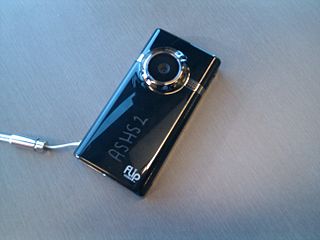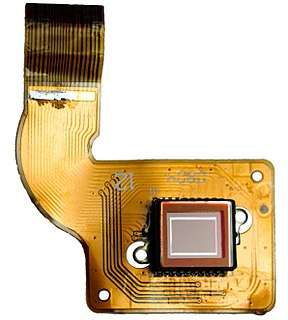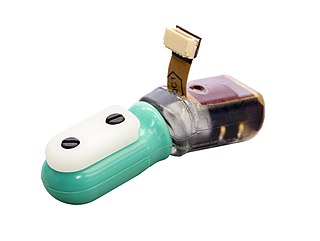
A charge-coupled device (CCD) is an integrated circuit containing an array of linked, or coupled, capacitors. Under the control of an external circuit, each capacitor can transfer its electric charge to a neighboring capacitor. CCD sensors are a major technology used in digital imaging.

In digital imaging, a pixel, pel, or picture element is a physical point in a raster image, or the smallest addressable element in an all points addressable display device; so it is the smallest controllable element of a picture represented on the screen.

A camera is an optical instrument used to record images. At their most basic, cameras are sealed boxes with a small hole that allow light in to capture an image on a light-sensitive surface. Cameras have various mechanisms to control how the light falls onto the light-sensitive surface. Lenses focus the light entering the camera, the size of the aperture can be widened or narrowed to let more or less light into the camera, and a shutter mechanism determines the amount of time the photo-sensitive surface is exposed to the light.
Digital image processing is the use of a digital computer to process digital images through an algorithm. As a subcategory or field of digital signal processing, digital image processing has many advantages over analog image processing. It allows a much wider range of algorithms to be applied to the input data and can avoid problems such as the build-up of noise and distortion during processing. Since images are defined over two dimensions digital image processing may be modeled in the form of multidimensional systems. The generation and development of digital image processing are mainly affected by three factors: first, the development of computers; second, the development of mathematics ; third, the demand for a wide range of applications in environment, agriculture, military, industry and medical science has increased.

Astrophotography is photography of astronomical objects, celestial events, and areas of the night sky. The first photograph of an astronomical object was taken in 1840, but it was not until the late 19th century that advances in technology allowed for detailed stellar photography. Besides being able to record the details of extended objects such as the Moon, Sun, and planets, astrophotography has the ability to image objects invisible to the human eye such as dim stars, nebulae, and galaxies. This is done by long time exposure since both film and digital cameras can accumulate and sum light photons over these long periods of time.

In the broadest definition, a sensor is a device, module, machine, or subsystem whose purpose is to detect events or changes in its environment and send the information to other electronics, frequently a computer processor. A sensor is always used with other electronics.

A thermographic camera is a device that creates an image using infrared radiation, similar to a common camera that forms an image using visible light. Instead of the 400–700 nanometre range of the visible light camera, infrared cameras are sensitive to wavelengths from about 1,000 nm (1 μm) to about 14,000 nm (14 μm). The practice of capturing and analyzing the data they provide is called thermography.
Digital imaging or digital image acquisition is the creation of a digitally encoded representation of the visual characteristics of an object, such as a physical scene or the interior structure of an object. The term is often assumed to imply or include the processing, compression, storage, printing, and display of such images. A key advantage of a digital image, versus an analog image such as a film photograph, is the ability to make copies and copies of copies digitally indefinitely without any loss of image quality.

A barcode reader is an optical scanner that can read printed barcodes, decode the data contained in the barcode and send the data to a computer. Like a flatbed scanner, it consists of a light source, a lens and a light sensor translating for optical impulses into electrical signals. Additionally, nearly all barcode readers contain decoder circuitry that can analyze the barcode's image data provided by the sensor and sending the barcode's content to the scanner's output port.

A video camera is a camera used for electronic motion picture acquisition, initially developed for the television industry but now common in other applications as well.

Omron Corporation, styled as OMRON, is a Japanese electronics company based in Kyoto, Japan. Omron was established by Kazuma Tateishi (立石一真) in 1933 and incorporated in 1948.

An infrared thermometer is a thermometer which infers temperature from a portion of the thermal radiation sometimes called black-body radiation emitted by the object being measured. They are sometimes called laser thermometers as a laser is used to help aim the thermometer, or non-contact thermometers or temperature guns, to describe the device's ability to measure temperature from a distance. By knowing the amount of infrared energy emitted by the object and its emissivity, the object's temperature can often be determined within a certain range of its actual temperature. Infrared thermometers are a subset of devices known as "thermal radiation thermometers".

Digital photography uses cameras containing arrays of electronic photodetectors to produce images focused by a lens, as opposed to an exposure on photographic film. The captured images are digitized and stored as a computer file ready for further digital processing, viewing, electronic publishing, or digital printing.

An image sensor or imager is a sensor that detects and conveys information used to make an image. It does so by converting the variable attenuation of light waves into signals, small bursts of current that convey the information. The waves can be light or other electromagnetic radiation. Image sensors are used in electronic imaging devices of both analog and digital types, which include digital cameras, camera modules, camera phones, optical mouse devices, medical imaging equipment, night vision equipment such as thermal imaging devices, radar, sonar, and others. As technology changes, electronic and digital imaging tends to replace chemical and analog imaging.
Document cameras, also known as visual presenters, visualisers, digital overheads, or docucams, are real-time image capture devices for displaying an object to a large audience. Like an opaque projector, a document camera is able to magnify and project the images of actual, three-dimensional objects, as well as transparencies. They are, in essence, high resolution web cams, mounted on arms so as to facilitate their placement over a page. This allows a teacher, lecturer or presenter to write on a sheet of paper or to display a two or three-dimensional object while the audience watches. Theoretically, all objects can be displayed by a document camera. Most objects are simply placed under the camera. The camera takes the picture which in turn produces a live picture using a projector or monitor. Different types of document camera/visualizer allow great flexibility in terms of placement of objects. Larger objects, for example, can simply be placed in front of the camera and the camera rotated as necessary,or a ceiling mounted document camera can also be used to allow a larger working area to be used.
A sensor is a device that measures a physical quantity and converts it into a signal which can be read by an observer or by an instrument.

A tactile sensor is a device that measures information arising from physical interaction with its environment. Tactile sensors are generally modeled after the biological sense of cutaneous touch which is capable of detecting stimuli resulting from mechanical stimulation, temperature, and pain. Tactile sensors are used in robotics, computer hardware and security systems. A common application of tactile sensors is in touchscreen devices on mobile phones and computing.

Ambarella, Inc. is a fabless semiconductor design company, focusing on low-power, high-definition (HD) and Ultra HD video compression, image processing, and computer vision processors. Ambarella's products are used in a wide variety of human and computer vision applications, including video security, advanced driver assistance systems (ADAS), electronic mirror, drive recorder, driver and in-cabin monitoring, autonomous driving, and robotics applications. Ambarella's system on chips (SoCs) are designed to deliver a combination of video compression, image processing, and computer vision performance with low-power operation to enable cameras to extract data from high-resolution video streams.

The HTC One (M8) is an Android or Windows smartphone manufactured and marketed by HTC. Following a number of leaks which occurred during the months prior, the device was officially unveiled in a press conference on March 25, 2014, and released the same day by Verizon Wireless at retail, and by other Canadian and United States carriers for online orders prior to its wider retail availability in mid-April.













